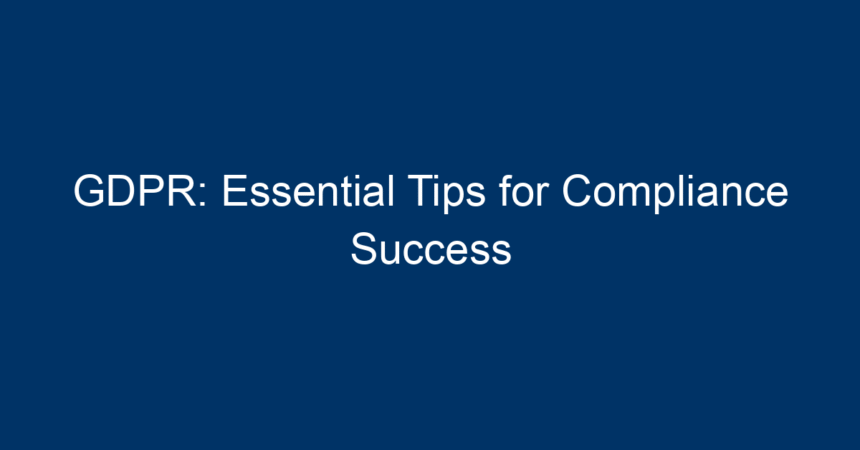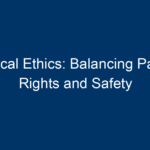The General Data Protection Regulation (GDPR) has transformed how organizations handle personal data. Enforced since May 2018, this regulation has far-reaching implications for businesses operating within the European Union and beyond. Understanding the intricacies of GDPR compliance is no longer optional; it’s essential for any organization aiming to protect consumer data and avoid substantial fines. In this article, we will explore essential tips for achieving GDPR compliance, guiding your organization toward successful implementation of data protection measures.
Understanding GDPR: A Brief Overview
Before diving into compliance strategies, it’s crucial to understand what GDPR is and why it matters. GDPR is a comprehensive data protection law that provides EU citizens with greater control over their personal data. It mandates that organizations must:
- Collect only the necessary data for specific purposes.
- Ensure transparency about how personal data is used.
- Obtain consent from individuals before processing their data.
- Implement robust security measures to protect data.
Non-compliance can lead to fines of up to €20 million or 4% of global annual turnover, emphasizing the importance of adhering to GDPR requirements.
Key Principles of GDPR Compliance
To achieve compliance, organizations must align with the core principles of GDPR. Here are the key principles to consider:
1. Lawfulness, Fairness, and Transparency
Organizations must process personal data lawfully, fairly, and transparently. This means:
- Lawfulness: You need a valid legal basis for data processing, such as consent or legitimate interest.
- Fairness: Data subjects should not be misled about how their data will be used.
- Transparency: Clear communication about data processing practices is essential.
2. Purpose Limitation
Data collected must be for specific, legitimate purposes and not processed in a manner incompatible with those purposes. Regularly review your data handling practices to ensure compliance.
3. Data Minimization
Only collect data that is necessary for your purposes. This not only helps in reducing risks associated with data breaches but also aligns with GDPR mandates.
4. Accuracy
Ensure that personal data is accurate and kept up to date. Implement processes to have outdated or incorrect data rectified promptly.
5. Storage Limitation
Keep personal data no longer than necessary for the purposes for which it was collected. Develop a data retention policy to manage how long you store data.
6. Integrity and Confidentiality
Protect personal data against unauthorized access, loss, or destruction through appropriate security measures. Conduct regular security assessments to identify and mitigate risks.
7. Accountability
Organizations should be able to demonstrate compliance with GDPR principles. This involves maintaining comprehensive records of data processing activities and regularly performing audits.
Essential Steps for GDPR Compliance
Here are actionable steps your organization can take to ensure GDPR compliance:
1. Conduct a Data Audit
Begin by identifying all personal data your organization collects. This includes understanding where it comes from, how it is processed, and who has access to it. A thorough data audit will help you gauge your compliance status and identify areas that need improvement.
2. Review and Update Privacy Policies
Your privacy policy must clearly outline how personal data is collected, used, and protected. Ensure it reflects GDPR transparency requirements and is easily accessible to users. Use straightforward language and avoid jargon to engage a broader audience.
3. Implement Consent Mechanisms
For any data processing that requires consent, implement clear and affirmative consent mechanisms. Ensure that users can easily give or withdraw consent and that consent records are maintained.
4. Train Your Employees
Employee awareness and training are crucial for GDPR compliance. Regular training sessions will help employees understand their responsibilities when handling personal data. This fosters a culture of compliance and data protection within your organization.
5. Appoint a Data Protection Officer (DPO)
If your organization processes large amounts of personal data or handles sensitive data, appoint a Data Protection Officer. The DPO will oversee data practices, ensuring compliance with GDPR and serving as a point of contact for data subjects and regulatory authorities.
6. Develop a Data Breach Response Plan
Prepare for potential data breaches by developing a response plan. This plan should include:
- Immediate actions to contain and assess the breach.
- Procedures for notifying affected individuals and the relevant authorities within 72 hours, as mandated by GDPR.
- Strategies for preventing future breaches.
7. Engage with Third Parties Wisely
If you rely on third-party services that process personal data, ensure they are GDPR compliant. Establish clear data processing agreements with vendors that outline responsibilities and compliance expectations. Regularly monitor third-party practices to maintain accountability.
Monitoring and Evaluating GDPR Compliance
Compliance is an ongoing process. Here’s how to monitor and evaluate your GDPR compliance continuously:
1. Regular Audits
Conduct regular data protection audits to assess your compliance status. Identify any weaknesses and take corrective actions as necessary.
2. Stay Informed on Regulatory Changes
GDPR regulations may evolve, so stay updated on legislative changes and best practices. Subscribing to industry newsletters and participating in webinars can keep you informed.
3. Collect Feedback
Engage with data subjects to gather feedback on your data processing practices. This can help identify potential issues and areas for improvement.
Conclusion: Your Path to GDPR Compliance
Achieving GDPR compliance is an ongoing journey that requires commitment and careful attention to detail. By understanding GDPR principles, implementing targeted strategies, and fostering a culture of compliance within your organization, you can navigate the complexities of data protection.
Actionable Insights:
- Perform regular audits and data assessments.
- Update policies and consent mechanisms proactively.
- Invest in employee training and awareness initiatives.
- Appoint a DPO to guide your organization in compliance efforts.
Embrace GDPR not just as a regulatory requirement, but as an opportunity to strengthen your organization’s data protection practices and build trust with consumers. By prioritizing GDPR compliance, you’re not only safeguarding personal data but also enhancing your reputation in a data-driven world.




